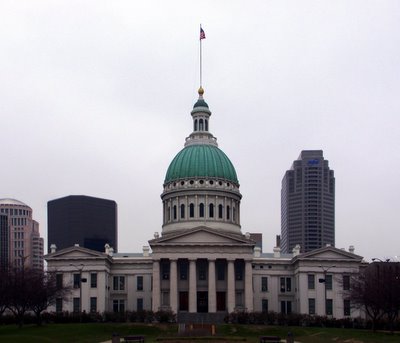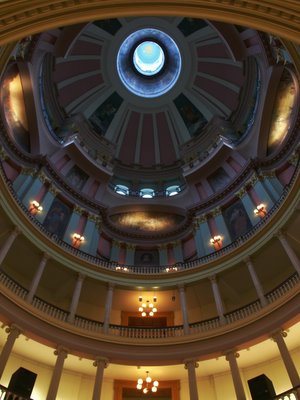
Here is the Old Courthouse, in downtown Saint Louis, Missouri. It is near the banks of the Mississippi River; the Gateway Arch is directly behind the camera, and is placed as a frame for this building with precise symmetry. The Basilica of Saint Louis, King of France is located just one block to the southeast, and all three structures are part of the Jefferson National Expansion Memorial. Click on any photo for a larger version. Its replacement, the Civic Courts building, is hidden behind the Old Courthouse. The building to the left, with a silvery dome, is the giant new Federal Courts building, the largest in the nation. Downtown Saint Louis is overflowing with lawyers!
This building has a dome in the style of the Italian Renaissance, as do many civic buildings of the United States, including most famously the Capitol Building in Washington, D.C. However, this is the first, the others are copies of it. What is remarkable is that this dome is modeled after Saint Peter's Basilica in Vatican City, and replaced a more republican Roman-style dome. The dome has a patented, lightweight wrought-iron frame that made such a structure possible with relatively thin walls and slender columns supporting it; it was completed in six months. Its architect, William Rumbold, designed a similar dome for the County Asylum (now St. Louis State Hospital).

The interior of the dome. It is decorated with paintings of personages and events in Saint Louis and Western history. Documents say that all of the Classical Orders are present in this dome.

Detail of the decoration inside of the drum below the dome. In the lunette is a painting by Charles Wimar; it depicts a pass in Colorado that was a proposed route for the then-planned transcontinental railroad, which would have gone through Saint Louis. With the decline of the steamboat trade, and the ascendancy of the rails through Chicago, Saint Louis was no longer the "Gateway to the West".
The Old Courthouse is the place where the infamous Dred Scott case got its start, and which led to the bloody American Civil War. Slavery in the United States was particularly severe compared with the rest of the Western Hemisphere, but there were some checks and balances. About two hundred slaves sued for their freedom in this courthouse, and about half of them were set free. Dred Scott appealed all the way to the United States Supreme Court, and lost his case.
Supreme Court Chief Justice Roger Brooke Taney was the first Catholic on that court. Earlier in his life, he freed his own slaves and supported emancipation, considering slavery "a blot on our national character". He was originally a Federalist but later became a Jacksonian, and became a stronger supporter of states rights, and generally moved towards Southern sympathies. As a supporter of states rights, he not only supported the power of states over the federal government, but also the power of states over private interests, advocating an expanded view of police powers.
Missouri was allowed into the Union as a slave state by a careful compromise by members of the United States Senate, which kept the equal balance of power between free and slave states in that legislative body. In the Dred Scott decision, Judge Taney ruled that the Missouri Compromise was unconstitutional, that each state was to decide for itself if it would be free or slave, and that blacks, even free blacks, had no standing as citizens, and being members of an inferior race, could not have access to the courts.
This led to Bleeding Kansas: radicalized supporters of both emancipation and slavery flocked into the Kansas Territory and battled over the future of the state. Soon after, civil war broke out, causing untold misery and death, and leaving scars in our Nation that have yet to heal.
Even though he was a Catholic, perhaps Judge Taney did not know about Sicut Dudum, the decree by Pope Eugene IV, promulgated in 1435, outlawing slavery by the Christian faithful, or Sublimis Deus, the decree of Pope Paul III, promulgated in 1537, that declared all races to be true men. Or perhaps he was just like every other Catholic politician in the United States, loyal to Party and not to the Moral Law.
The slavery issue had three parties: the slaves themselves, deprived of rights; the slaveowners who depended on their slaves for their livelihood (and their supporters); and the emancipationists, who were a disinterested party who nevertheless struggled for the rights of the slaves out of a sense of justice. The emancipationists won by violence. Hundreds of thousands died, and the condition of the freed slaves was miserable.
The Dred Scott decision was an aberration, was bad law, went too far, and neglected the great efforts of statesmen and politicians to keep the peace. Taney, it has been said, was most definitely not a statesman, and had little concept of the "Higher Law".
Likewise, the Roe v. Wade decision is an aberration, is bad law, went too far, and neglected the work of the various legislatures in our country.
The abortion issue has three parties: the unborn who have no rights; the mothers for whom giving birth to a child is a great personal burden (and their supporters); and the Pro-Life supporters who are a disinterested party who support the rights of the unborn out of a sense of justice. So far violence over this issue has been minimal.
Emancipation only happened through war because no provision was made for reimbursing the slaveowners for their lost property; ironically, the great monetary cost of the Civil War (and the near total financial loss to property owners during the war) would have easily paid for reimbursement of slaveowners many times over. Instead, slaveowners were seen as being evil, with no rights for compensation whatsoever. Also, no provision was made for the emancipated slaves: the 'forty acres' promised to every freed slave is now called the National Park Service. This relatively trivial amount of land could have ensured that the former slaves made lives for themselves, but instead we rely on vastly more expensive social programs today.
Likewise, solving the abortion problem (and similarly the euthanasia problem) is likely to be expensive: but perhaps it could be relatively cheap compared to the alternative. Like slaveowners of the past, mothers facing an unwanted pregnancy have an actual, real, and direct burden that they must face. They will most likely have financial, social, and health burdens due to their condition. Unlike the emancipationists of the past, Pro-Life supporters must be prepared to relieve these mothers of their burdens, and must be willing to support these unwanted children. Under no circumstances are we to view these mothers as evil as emancipationists viewed the slaveholders of the past. And because the Federal Government can hardly be trusted to do the right thing in such matters, it is up to private citizens and organizations to do the work.
Systems will need to be set up that will guarantee mothers of unwanted children financial support, healthcare, discretion, lovingkindness, and absolute secrecy. Otherwise, supporters of abortion rights will see an overturn of Roe v. Wade as a direct attack, and will respond violently. Likewise, adoptions need to be fast, inexpensive, and absolutely guarantee the rights of the adoptive parents.
There were once vast Religious Orders that cared for unplanned pregnancies, and large Catholic families who could easily find room for one more mouth to feed. Protestants, too, made this a priority. It is something that everyone can help with. This problem will never go away, and we can only hope that better preaching and a restored public morality can lessen it.
Many are delighted that there may be another Catholic on the Supreme Court. History shows that we should not be so optimistic; and even if we get what we want, chaos may occur.


No comments:
Post a Comment